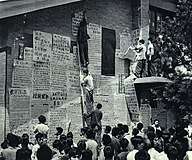Big-character poster
Big-character posters (simplified Chinese: 大字报; traditional Chinese: 大字報; pinyin: dàzìbào; Wade–Giles: ta4-tzu4-pao4; lit.: 'big-character reports', Albanian: fletërrufe) are handwritten, wall-mounted posters using large-sized Chinese characters (or Latin characters for Albanian language) used as a means of protest, propaganda, and popular communication.
History
In China
Dazibao have been used in China since imperial times, but became more common when literacy rates rose after the 1911 Xinhai Revolution. They have also incorporated limited-circulation newspapers, excerpted press articles, and pamphlets intended for public display.


A key trigger in the Cultural Revolution was the publication of a dàzìbào on 25 May 1966, by Nie Yuanzi (聂元梓/聶元梓) and others at Peking University, claiming that the university was controlled by bourgeois anti-revolutionaries. The poster came to the attention of Mao Zedong, who had it broadcast nationally and published in the People's Daily. Dazibao became a crucial tool in Mao's struggle during the Cultural Revolution, and Mao himself wrote his own dazibao at Beijing University on 5 August 1966, calling on the people to "Bombard the Headquarters".[1] Big-character posters were soon ubiquitous, used for everything from sophisticated debate to satirical entertainment to rabid denunciation; being attacked in a big-character poster was enough to end one's career. One of the "four great rights" in the 1975 state constitution was the right to write dàzìbào.
Big-character posters sprouted again during the Democracy Wall movement, starting in 1978 (Beijing Spring); one of the most famous was "The Fifth Modernization", whose bold call for democracy brought instant fame to its author, Wei Jingsheng.[2]
In more recent times, these have been replaced with "Heng Fu" (横幅, lit. 'horizontal scroll') with "Biao Yu" (标语, an inspirational or motivational message or an announcement) inscribed on them.[3] These long red coloured banners with white or yellow Chinese characters are found all over China in residential complexes as well as in universities and schools.[4][5]
In Albania
Big-character posters appeared also in Albania as a result of Albania's Cultural Revolution, imported from China in 1967 in communist Albania. Called fletërrufe in the Albanian language, it was used by the Party of Labor of Albania to both spread communist ideas, as well as to publicly denounce and humiliate possible deviators from the Party's line.[6][7]
See also
- Propaganda in the People's Republic of China
- Newspapers of the People's Republic of China
- Media in the People's Republic of China
- The Daily Talk
- Wall newspaper
- Pashkevil
- Talking statues of Rome
External links
References
- Lincoln Cushing; Ann Tompkins (2007). Chinese Posters: Art from the Great Proletarian Cultural Revolution. Chronicle Books. p. 5. ISBN 978-0811859462.
- "Chairman Mao and life of the common people during the cultural revolution". projects.zo. Project Heidelberg. Retrieved 5 September 2019.
- Rajagopal, Sriram. Living in China: A contemporary narrative.
- Chen, Janet. The search for Modern China. WW Norton & Company.
- Boise, Edwin. Modern China: A history (3 ed.). Routledge.
- Andreas Hemming; Gentiana Kera; Enriketa Pandelejmoni (2012). Albania: Family, Society and Culture in the 20th Century. LIT Verlag Münster. pp. 181–. ISBN 978-3-643-50144-8.
- Silke Satjukow; Rainer Gries (2004). Unsere Feinde: Konstruktionen des Anderen im Sozialismus. Leipziger Universitätsverlag. pp. 535–. ISBN 978-3-937209-80-7.